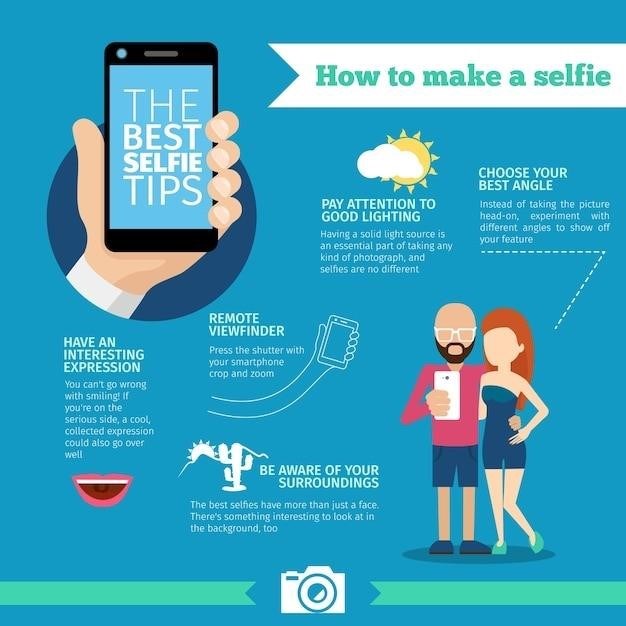
Polaroid Snap Camera⁚ A Comprehensive User Guide
This guide provides a complete walkthrough of the Polaroid Snap instant print digital camera‚ covering setup‚ operation‚ troubleshooting‚ and maintenance. Learn to capture and print photos‚ utilize advanced features‚ and connect to smartphones for enhanced functionality. Explore the included manual for further details and support.
Getting Started⁚ Unboxing and Initial Setup
Unboxing your Polaroid Snap reveals the camera‚ a USB charging cable‚ a wrist strap (sometimes included)‚ and potentially an instruction manual. Before taking your first picture‚ ensure the camera is fully charged. Locate the power button‚ typically on the top or side. To turn on the camera‚ press and hold the power button until the viewfinder extends and the screen lights up. Familiarize yourself with the camera’s basic components⁚ the lens‚ shutter button‚ power button‚ and the paper slot. The initial setup is straightforward; no complex software installation is required. Once powered on‚ the camera is ready to capture your memories. A quick glance at the provided manual is recommended for more detailed information on the placement of the camera’s components. Remember to check for any included accessories like additional straps or protective cases. Enjoy the simplicity and ease of use designed into the Polaroid Snap camera.
Charging the Camera and Battery Indicator
The Polaroid Snap camera utilizes a rechargeable battery. Charging is accomplished using the included USB cable‚ connecting it to a standard USB power adapter (not always included; check your package contents). Plug the USB cable into the designated port on the camera; this is typically marked with a symbol or located near the power button. The charging process is indicated by a light‚ usually an LED‚ near the charging port. This LED will typically illuminate while charging and turn off once the battery reaches full capacity. A full charge usually takes around two hours‚ though charging times may vary slightly. Avoid using the camera while it’s charging to ensure optimal performance. A low battery indicator‚ often a flashing light or a low battery symbol on the display‚ will alert you when it’s time to recharge. Always use the appropriate USB power adapter to avoid damaging the camera or battery. Regular charging will extend the life of your battery and ensure you’re always ready to capture those spontaneous moments.
Understanding the Camera Components
Familiarize yourself with the Polaroid Snap’s key features. The lens is typically located on the front‚ often protected by a lens cover. The power button is usually situated near the lens or on the top of the camera. A viewfinder‚ if present‚ allows for framing your shots. The shutter button initiates the photo-taking process‚ often located near the power button. An SD card slot (on many models) enables storage of digital images beyond instant prints. The paper slot is where you insert and eject the Zink photo paper. Many models feature an LED indicator light that displays the camera’s status—charging‚ power‚ errors‚ etc. Some models include a small LCD screen for image review and settings adjustments. The charging port is where you connect the USB cable for recharging the battery. Finally‚ a strap or loop may be present for attaching a wrist strap for secure handling. Refer to your specific camera model’s manual for precise locations and functionalities of these components. Understanding their purpose ensures smooth and efficient use of your Polaroid Snap.
Taking Your First Photos⁚ Basic Operation
Begin by ensuring your Polaroid Snap camera is powered on and that Zink photo paper is correctly inserted. Compose your shot using the viewfinder (if applicable) or the LCD screen. Hold the camera steadily‚ minimizing camera shake for sharper images. Gently press the shutter button to capture the image. The camera will process the photo‚ and if using Zink paper‚ it will then eject a physical print. Experiment with different distances and lighting conditions to get a feel for your camera’s capabilities. Remember‚ the closer you are to your subject‚ the larger it will appear in the final print. For optimal results‚ ensure adequate lighting; avoid harsh backlighting which can cause overexposure or shadows. If your camera has digital storage (SD card)‚ the image will also be saved digitally for later viewing or sharing. Review your first photos to understand how lighting and distance affect the final print quality. Practice makes perfect – take several shots to refine your technique and become comfortable using the Polaroid Snap;
Inserting and Refilling Photo Paper
Before inserting new Zink photo paper‚ ensure the camera is switched off. Locate the paper tray; it’s usually on the side or back of the camera. Open the tray by gently pressing the release latch or button. Carefully remove any remaining paper. Insert a new stack of Zink photo paper‚ ensuring the images are facing outwards‚ as indicated by the arrows or markings on the paper tray. Ensure the paper is properly aligned and seated correctly within the tray; Close the tray firmly until you hear a click‚ confirming that it’s securely shut. Turn the camera back on. If the camera displays an error message regarding the paper‚ double-check the alignment and ensure the paper isn’t bent or damaged. Avoid using more than the recommended number of sheets at a time to prevent jams. To refill‚ simply repeat the process once the previous stack is depleted. Always handle Zink paper carefully to avoid smudging or damaging the photos before they are printed. Proper paper handling and insertion are crucial for smooth operation and to prevent errors or jams.
Troubleshooting Common Issues⁚ Paper Jams and Error Codes
Paper jams are a common issue with instant cameras. If a jam occurs‚ the camera will usually indicate this with a flashing red light or an error message. Before attempting to fix the jam‚ turn off the camera. Gently open the paper tray and carefully remove any jammed paper. Avoid tearing or bending the paper. If the paper is stuck inside‚ use tweezers or a thin‚ non-metallic object to carefully extract the jammed sheets. Be gentle to avoid damaging the internal mechanisms of the camera. After removing the jammed paper‚ inspect the remaining sheets for any bends or creases‚ discarding any damaged ones. Reinsert the remaining paper correctly‚ ensuring it is aligned and not bent. If the problem persists‚ refer to your camera’s user manual for specific instructions on troubleshooting paper jams‚ and consider contacting Polaroid customer support. Error codes displayed on the camera’s screen usually indicate specific problems. Consult the camera’s manual to understand the meaning of each code and the recommended solutions. If the issue continues after following troubleshooting steps‚ contact customer support for further assistance.
Advanced Features⁚ Photo Booth Mode and SD Card Usage
The Polaroid Snap offers a fun Photo Booth mode‚ perfect for capturing quick‚ playful shots with friends and family. To access this mode‚ locate the designated setting on your camera’s menu (consult your user manual for exact instructions). Photo Booth mode typically allows for a rapid succession of photos‚ creating a dynamic sequence. This feature is ideal for creating memorable group photos or capturing spontaneous expressions. Remember to ensure sufficient lighting and stable positioning for optimal results. The Polaroid Snap also features an SD card slot‚ allowing you to store digital copies of your photos. This is particularly useful for preserving your memories beyond the physical prints. Inserting an SD card is generally straightforward; carefully insert the card into the designated slot‚ ensuring it’s properly aligned. The camera’s manual will provide detailed instructions on SD card insertion and formatting‚ if necessary. Using an SD card allows you to take numerous photos without running out of space for printing‚ enabling you to capture more memories. Remember to regularly back up the data on your SD card to prevent data loss.
Connecting to a Smartphone via Bluetooth
Connecting your Polaroid Snap to your smartphone via Bluetooth expands its capabilities‚ allowing for remote control and image transfer. First‚ ensure Bluetooth is enabled on both your smartphone and the Polaroid Snap camera. On your smartphone‚ navigate to the Bluetooth settings menu and activate Bluetooth functionality. Next‚ locate the Bluetooth pairing mode on your Polaroid Snap; consult your user manual for specific instructions as the process may vary slightly depending on your camera model. Once the camera is in pairing mode‚ it should appear as a discoverable device on your smartphone’s Bluetooth list. Select the Polaroid Snap from the list to initiate the pairing process. You may need to enter a passcode if prompted; this information can usually be found in the camera’s manual. Once paired‚ you can use your smartphone to control certain camera functions‚ such as taking photos remotely. Additionally‚ you might be able to transfer photos stored on the camera’s internal memory or SD card to your smartphone for easy sharing or backup. Refer to your camera’s user manual or the accompanying app (if applicable) for detailed instructions on utilizing the Bluetooth connection and its associated features. Remember that Bluetooth range is limited‚ so keep your phone relatively close to the camera for a stable connection.

Using the Polaroid Snap App (if applicable)
Enhance your Polaroid Snap experience with the dedicated mobile application‚ if available for your camera model. This app typically offers expanded functionality beyond the camera’s built-in controls. Download the Polaroid Snap app from your smartphone’s app store (Google Play or Apple App Store). After installation‚ launch the app and follow the on-screen instructions to connect it to your Polaroid Snap camera. This usually involves enabling Bluetooth on both devices and selecting your camera from a list of available devices. Once connected‚ the app unlocks several features‚ such as remote shutter control‚ allowing you to take pictures from a distance. You might also find options for adjusting camera settings remotely‚ such as altering brightness‚ contrast‚ or other image parameters. The app often provides a streamlined way to manage photos stored on your camera’s internal memory or SD card. You can easily browse‚ select‚ and download your pictures directly to your smartphone for sharing or backup. Some apps offer additional creative tools‚ including filters and editing features to enhance your photos before saving or sharing them. Check the app’s description in the app store for specific features and compatibility information. Remember that app functionality may vary depending on your camera model and the app version.
Memory Card Management and Storage
The Polaroid Snap camera offers the flexibility of using an SD card (sold separately) to expand its storage capacity beyond its internal memory. This is crucial for users who frequently capture many high-resolution images. To insert an SD card‚ locate the designated SD card slot on your camera; consult your camera’s manual for its exact location. Gently insert the card‚ ensuring it’s correctly oriented. The camera will usually automatically detect and recognize the inserted SD card. The camera’s LED indicator might provide visual cues regarding memory card status. A red light could signal low memory‚ while a blinking red light might indicate an error. Regularly check the remaining storage space available on your SD card to prevent unexpected interruptions during photo sessions. When the memory on the SD card is nearly full‚ transfer your photos to a computer or other storage device to free up space. You can manage your photos using a computer‚ directly connecting the camera via USB‚ or by using the Polaroid Snap app (if applicable) to wirelessly transfer photos. Remember to always safely remove the SD card before disconnecting the camera from a computer or before turning the camera off to prevent data loss. Properly ejecting the SD card prevents file corruption and ensures data integrity. For optimal performance‚ use a high-quality SD card rated for your camera’s specifications.
Maintaining Your Polaroid Snap⁚ Cleaning and Care
Proper care ensures your Polaroid Snap camera’s longevity and optimal performance. Avoid exposing the camera to extreme temperatures‚ moisture‚ or direct sunlight for extended periods. These conditions can damage internal components or affect the camera’s functionality. To clean the camera’s exterior‚ use a soft‚ dry cloth to gently wipe away dust and fingerprints. For stubborn smudges‚ lightly dampen the cloth with distilled water; avoid using harsh chemicals or abrasive cleaners that could scratch the camera’s surface. Keep the lens clean; use a specialized lens cleaning pen or a microfiber cloth designed for optics. Avoid touching the lens directly with your fingers‚ as oils and dirt can compromise image quality. If the camera’s exterior requires more thorough cleaning‚ consult the camera’s manual for specific instructions or contact Polaroid customer support. Regularly check the battery compartment and charging port for any debris. Gently remove any dust or lint using a compressed air canister. For more detailed cleaning instructions‚ refer to the comprehensive user manual provided with your camera. Proper maintenance will ensure your Polaroid Snap delivers years of enjoyable instant photography. Remember‚ preventative care is always better than extensive repairs. By following these simple guidelines‚ you can keep your Polaroid Snap in top condition‚ ensuring clear images and reliable performance.
Where to Find Additional Support and Resources
For comprehensive assistance and troubleshooting‚ Polaroid offers various support channels. Their official website provides detailed user manuals‚ FAQs‚ and software updates. The website’s support section often features video tutorials demonstrating camera operation and addressing common issues. Should you encounter difficulties not covered in the online resources‚ Polaroid’s customer service is readily available via phone or email. Contact details are usually found on the website’s support page‚ allowing direct communication with their technical experts. Many online forums and communities dedicated to Polaroid cameras offer user-generated content‚ troubleshooting tips‚ and advice from experienced users. These platforms can be valuable resources for finding solutions to specific problems or learning advanced techniques. Remember to carefully review the warranty information included with your Polaroid Snap camera; understanding the warranty terms ensures you receive appropriate support should any issues arise within the warranty period. YouTube also hosts numerous videos demonstrating various aspects of Polaroid Snap usage and maintenance. These videos often provide visual aids that clarify written instructions. By utilizing these combined resources‚ you can effectively troubleshoot problems‚ learn new features‚ and maximize your Polaroid Snap’s potential.
